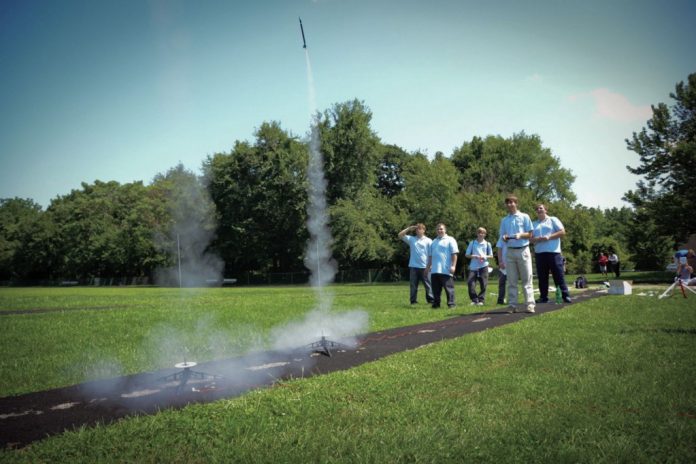Does the word “trigonometry” stir painful high school memories? Did you suffer through sines and tremble through tangents?
Believe it or not, some students at Father Judge recently had some fun with trig. Of course, they were setting off rockets at the time.
Fifteen Judge students, along with teachers Art Gutzler and Joy Kots, launched 18 model rockets on the school’s soccer field on Aug. 16 as they were winding up a two-week summer science program. The instruction included training at Drexel University and the National Aerospace Training and Research Center in Southampton.
Students used trigonometry to measure how high their rockets soared, said Greg Kennedy, NASTAR’s educational services director.
A couple of the students set up equipment that measured the rockets’ angles of ascent, Kennedy said during a phone interview last week. They were a set distance from the launch site. Using that distance and the angle measurements, they were able to use the trig function tangent to measure the rockets’ zeniths before they started to descend.
The foot-high, 3-ounce rockets, assembled from kits, rose about 200 feet before they came back down to Earth. Their descent was slowed by plastic sheeting that deployed, Kennedy said.
The launches demonstrated Newton’s Laws of Motion as well as acceleration and the principles of action and reaction.
“We had a ball,” he said.
Setting off rockets at the high school’s Solly Avenue campus occurred near the end of a two-week program designed by the Education Committee of the high school’s board of advisers. The program began on Aug. 6 at Drexel’s School of Biomedical Engineering, Science and Health Systems.
Five Drexel students, part of Drexel’s weServe Program, provided a college perspective for the Judge juniors and seniors, said the Rev. James Dalton, the high school’s principal.
Under the supervision of weServe director Shirin Karsan, the Judge students learned in the first week about the development of the human body, biological rhythms and physiology as applied to aerospace. They engineered a soft landing of an egg from a balcony and dissected a pig’s heart.
From Aug. 13 through 17, the Judge students learned about the theory and mechanics of flight and rockets at NASTAR, a subsidiary of Environmental Tectonics Corp., which manufactures aviation search and training equipment like flight simulators.
“This is the first time we did a high school program,” Kennedy said.
The rockets the students set off on Aug. 16, were models of 20-foot UP Aerospace Spaceloft XL, Kennedy said, which is a rocket that is available for commercial uses.
Although the models come in kits, their motors come pre-manufactured, Kennedy said. They’re very safe, he added. The students don’t handle propellants.
“The rocket has a black powder-based propellant,” he said. That launches the rocket, and it accelerates until it reaches its apex, or highest point, and then a charge in the top pushes out the rocket’s recovery system, a plastic streamer, and then the rocket descends, Kennedy said.
Students also launched 20-ounce plastic soda bottles, Kennedy said, by rigging up water and air pressure, using a bicycle pump.
Those rockets weren’t kits, Kots said in a phone interview Aug. 24. The students designed them.
“They got to tinker with what works and with what doesn’t work,” she said.
On the last day of the program, the Judge students piloted a flight simulator, Kennedy said.
“They loved that,” he said. “They got a chance to see what it feels like to fly an airplane.”





